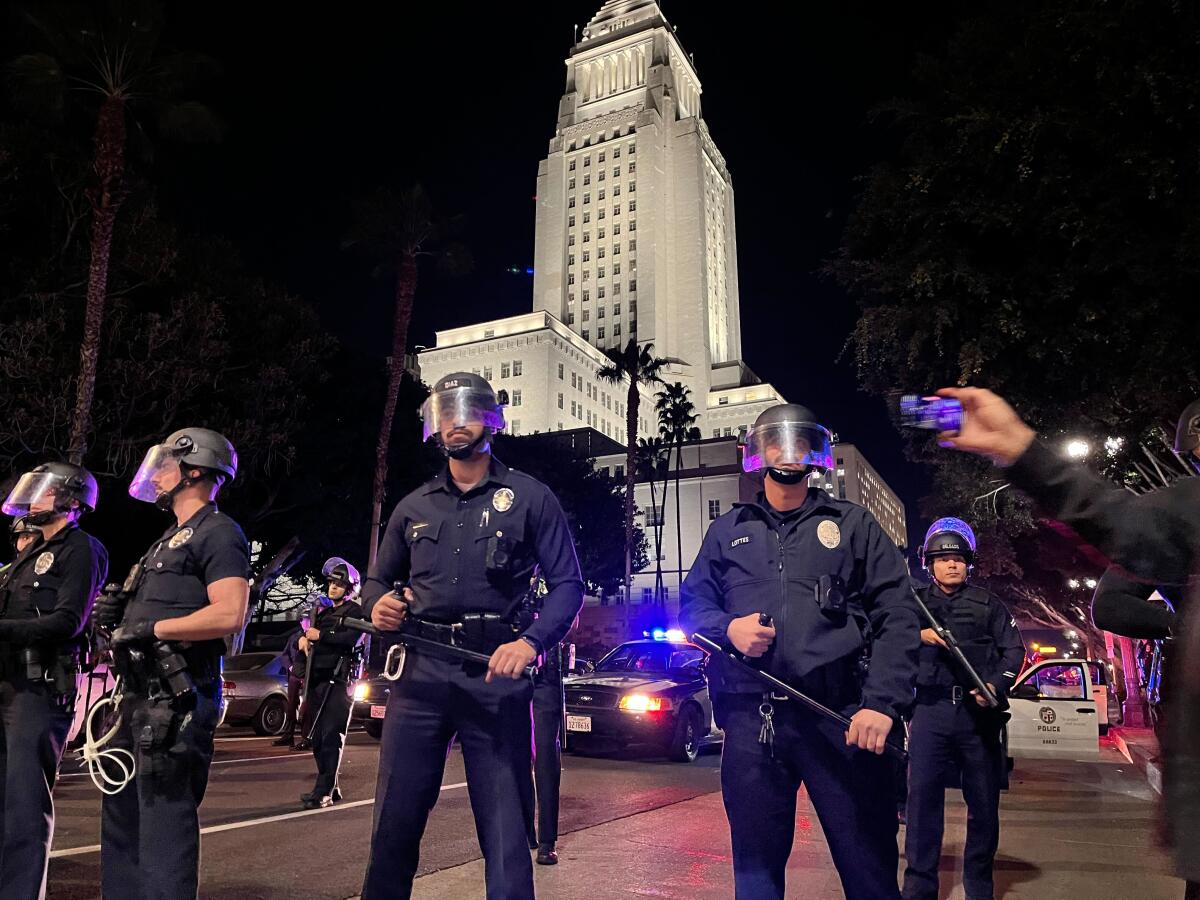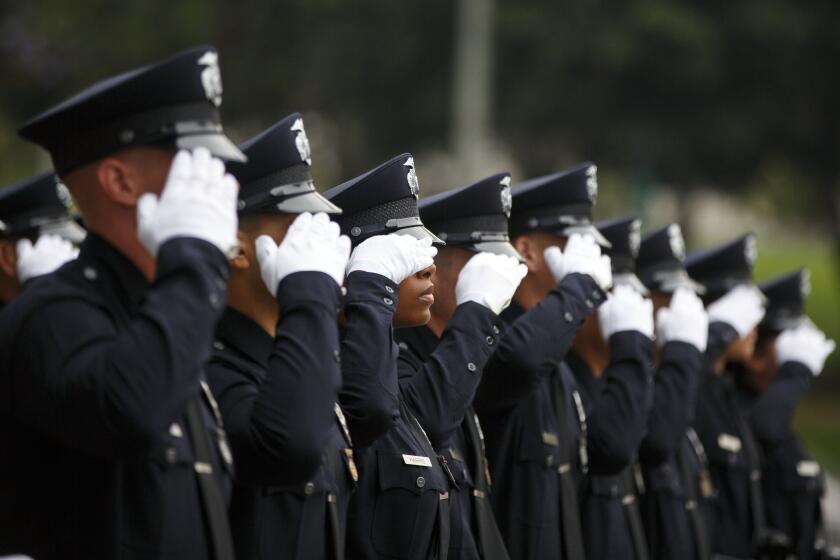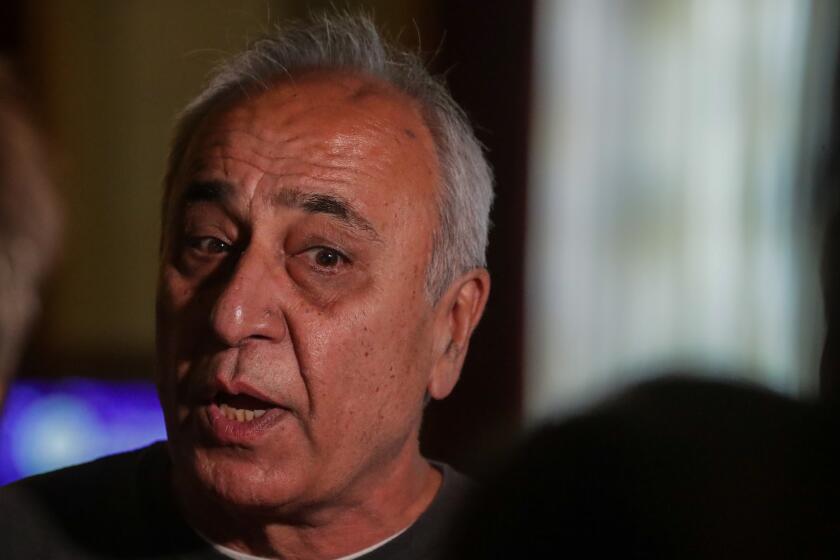A big question remains amid LAPD photo scandal: Just who is an undercover officer?

- Share via
As fallout continues around the Los Angeles Police Department’s release of undercover officers’ pictures, the question of who actually works undercover is far from settled.
Should it only be officers involved in the most sensitive assignments — embedded with drug cartels, terrorists and other criminal networks — who grow beards, dye hair, shed their identities?
Or should it also include those who only go undercover part time, busting johns who solicit sex or bartenders who sell alcohol to minors? And what about officers with fake online profiles?
The fraught and complicated issue of covert police activity has been made more so, as Los Angeles Police Department and police union officials try to claw back the images released in response to a March public records request. They argue that the danger such public photos present to officers who have assumed aliases to infiltrate the underworld overrides calls for transparency.
But some critics dismiss the LAPD’s claims as overblown and accuse the department of drumming up hysteria in the media as cover for its efforts to expand the definition of which officers’ identities should be kept from the public.
The photos’ release has raised fresh questions about just how much oversight there is of these undercover operations, given the LAPD’s “horrific history of spying” on and keeping lengthy dossiers on politicians, activists and others, said longtime civil rights attorney Carol Sobel.
“They had a Red Squad that infiltrated activist groups; the LAPD targeted the likes of Cesar Chavez [and former Mayor] Tom Bradley,” said Sobel. “To maintain their cover, undercover officers were known to have had sex with activists.”
The city released the images last fall in response to a public records request and related litigation by Knock LA journalist Ben Camacho. Camacho subsequently provided the images — complete with officers’ names, ethnicity, rank, date of hire, division/bureau and serial numbers — to the activist group Stop LAPD Spying Coalition, which published them online in mid-March.
LAPD union sues the chief to prompt him to get undercover officer photos off the web, and wants the activist website Watching the Watchers taken down until the city determines which images should be excluded
Camacho has posted communications with city officials prior to the photos’ release in which they said the disclosure did not include any undercover officers. But after the photos were published last month, LAPD Chief Michel Moore and other officials began to suggest in news interviews that the photos of some undercover officers were accidentally released and posed a safety risk.
The disclosure has spawned several legal challenges, the most recent of which came last week when city officials filed a lawsuit against Camacho and Stop LAPD Spying over the photos’ publication. The city’s suit was roundly condemned by 1st Amendment and media rights experts who said it smacks of restrictions on free speech — particularly since the city itself provided the images.
Amid the unfolding controversy, LAPD officials have avoided the term “undercover.” Moore has repeatedly used the phrase “sensitive assignment” — a term that could encompass a broad variety of officers.
In a departmentwide email last week, Moore said he ordered an audit of officers in more sensitive roles whose personal information wouldn’t be released in the future. Certain roles, he wrote, “require this added level of anonymity to preserve officers’ safety and to ensure that investigations are not compromised if the identity of the employee as a police officer is revealed.”
“As employees of this Department and dedicated guardians of the City of Los Angeles, you deserve to feel protected and supported by your employer. I recognize that many of you feel that the Department did not meet this expectation. Apologies only go so far, and words must be followed by action,” Moore wrote.
He included a list of units and divisions whose officers’ photos would automatically be excluded from future public disclosures. Among them are: divisional narcotics enforcement details; vice units; gang enforcement details; the Gang and Narcotics Division; Major Crimes Division; Robbery-Homicide Division; Special Investigation Section; Special Operations Division; Crime Impact Team; Internet Crimes Against Children; all division or bureau-based surveillance teams; and officers who regularly serve on task forces.
Such exemptions could include officers working undercover only part time, Moore wrote.
Others who would be excluded from future public disclosures are officers who do online surveillance, work plainclothes details, conduct long-term investigations of violent offenders or networks, investigations that are of “such extraordinary or unusual nature that it creates an unprecedented level of threat to your safety.”
Also excluded, Moore wrote, are “any positions which require regular, repeated, or extended contact or exposure to violent criminal offenders, outside of the standard duties required of patrol officers” and “any position which would expose you to criminal offenders who have extensive financial and technological resources which could be used in retaliatory action against you or your family.”
A review of a recent LAPD roster shows there are at least 307 officers combined in the Gang and Narcotics, Robbery-Homicide, Major Crimes and Special Operations divisions alone. It was not immediately clear how many more are assigned to the other “sensitive” units mentioned in Moore’s email.
At Tuesday’s meeting of the Los Angeles Police Commission, William Briggs, commission president, said he remained concerned about the disclosure and asked Moore what was being done to ensure officers’ safety. He asked the department to look into whether “we can simply prohibit the release of certain identity information such as photographs because of the danger that it places department personnel in.”
After the meeting, Moore said in a news briefing that “to date, the vast majority of our operations, undercover operations included, have not been impacted by this.”
But, he added, “we know that the potentiality is there.”
Some longtime police observers said officials with the LAPD and Los Angeles Police Protective League have at times offered different definitions of what it means to be undercover officer.
“It’s anybody’s guess,” said Hamid Khan, of Stop LAPD Spying Coalition, a group that wants to abolish the Police Department and first published the photos on a website called, Watch the Watchers.
If anything, the department was using the controversy to be less transparent, Khan said, adding that this is particularly troubling given its history of surveillance of communities of color. Stop LAPD Spying tweeted Tuesday that the city appeared to be quietly deleting LAPD personnel rosters from its public data portal.
Khan said he doubted the city’s claims that officers’ lives were in danger because their photos were public. The site is only publishing information about officers that a judge ruled the public is entitled to — and not private data such as officers’ addresses, he said.
“Giving them the ability to retroactively redefine [undercover] is really dangerous,” said attorney Shakeer Rahman of the city’s lawsuit, which he called a clear attempt by officials to “intimidate community groups that are critical of LAPD.”
“One elected city attorney defines undercover in one way, and another comes in and says actually we’re going to define it much more narrowly,” said Rahman, who has represented both Camacho and Stop LAPD Spying in past legal actions against the city. “If they’re allowed to do that, that could really be ripe for abuse.”
Within the LAPD, officers who work in an undercover capacity generally fall into one of two tiers. Only about 50 or so officers are truly considered “off the books,” working on deep cover operations with outlaw biker gangs, terrorist groups or drug cartels. Their names are kept out of the department records and are known to only a handful of superiors. Most have changed their physical appearance and assumed fictitious identities, all the way down to a new driver’s license. Some are based outside the state.
Chief Michel Moore, citing safety concerns, said the inspector general will investigate the disclosure of officers’ photos in an online database launched by the Stop LAPD Spying Coalition.
Dozens, if not hundreds, more officers work in varying degrees of anonymity on a part-time basis, from doing low-level drug buys to running surveillance on chronic violent offenders. The department also maintains a secretive cadre of investigators, known as the Special Operations Division, which keeps an eye on other cops suspected of misconduct.
According to an LAPD training bulletin, undercover officers must submit detailed operational plans, outlining which department personnel and equipment will be involved and relevant information about the location, such as whether security bars or dogs are present.
Undercover officers are instructed to immediately identify themselves “and cooperate with any direction given by the uniformed officers and calmly explain the situation to the officers while continuing to follow instructions and commands.”
“More importantly, personnel assigned to UC [undercover] or surveillance operations should avoid making any sudden movements, which includes reaching for police identification. Such movements could easily be mistaken for a threatening gesture,” the bulletin says.
A former LAPD supervisor, who because of the nature of the work could not be named, said there are at least three dozen officers and detectives who have worked in the most sensitive types of investigation involving counter-terrorism. Such investigators usually work with other agencies with higher levels of security clearance, the supervisor said.
Dan Murphy, a consultant with the Minnesota-based firm 360 Security Services, said that photos spread online could be “potentially very dangerous to the lives and safeties” of undercover officers, who often go to great lengths to build and maintain their covers. To be effective, they have to earn the trust of the people they’re investigating — knowing that any whiff of their true identities could put them at risk.
“Underground criminal networks do a lot of work, they do a lot of background work, they make sure they know who they’re dealing with if they’re making money,” Murphy said. “There are many instances when [undercover officers] find themselves moving up the food chain in an organization, and they need to be covered in ways so that their identities can’t be revealed with a five-minute online search.”
An undercover LAPD veteran who regularly deals with Mexican drug cartels said they now use counter-surveillance. The cartels get photos and video of takedowns by the Police Department and its federal partners and compare the images to booking photos of suspects to identify undercover operatives. The release of officers’ photos makes that effort much easier, he said.
“This is the most serious compromise of undercover operations in decades,” said the investigator and supervisor. “We have had cartels come after specific detectives, but nothing like this that threatens so many of us. ... They can put faces to names and compare images to those released.”
Murphy, a retired New York City Police Department detective sergeant who worked “many” undercover operations, said he recognizes that people don’t want to live in a “police state.” But, he thinks the push for “full transparency” around law enforcement ignores the fact that some investigations have to be carried out in secret to succeed.
Most police departments today have safeguards against abuses, having learned from past scandals in which questionable tactics eventually came to light, he said.
“If you make a criminal case, that all comes out in a courtroom,” he said.
Like most big-city departments, the LAPD has long maintained an intelligence-gathering wing.
In the 1980s, before Karen Bass became the L.A. mayor, she was part of a group of activists who — with the American Civil Liberties Union — sued then-Police Chief Daryl Gates and the LAPD for spying on them. In retaliation, Gates released information about Bass’ trips to Cuba and falsely asserted she had gone there to learn guerrilla warfare.
Until the program was shut down in the late 2010s, the department used to send undercover officers into schools to pose as students — a program that was popularized in the “21 Jump Street” TV show and movies.
But officers who conduct surveillance aren’t necessarily all undercover, said Sobel, the civil rights attorney.
“They order officers into uniform for all these large protests,” she said. “When they put officers in uniform at protests, it exposes them as officers.”
In 2019, the department drew fire after it was revealed that the LAPD’s Major Crimes Division sent an informant to secretly record the meetings of Refuse Fascism, an anti-Trump group. Civil rights advocates and other critics at the time blasted the department’s tactics for needlessly infringing on the group’s 1st Amendment rights, since it has rarely been linked to violence.
After that scandal, the LAPD implemented a series of reforms to provide oversight of such operations in the future, including requiring the approval from senior officials such as the president of the Police Commission.
But it’s exactly because of the department’s unchecked surveillance over its history that sites such as Watch the Watchers are needed, said Khan, of Stop LAPD Spying.
“For us, it’s extremely, extremely concerning about how vast this surveillance, spying and infiltration apparatus is,” he said.
More to Read
Sign up for Essential California
The most important California stories and recommendations in your inbox every morning.
You may occasionally receive promotional content from the Los Angeles Times.














